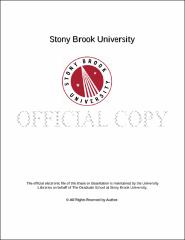| dc.identifier.uri | http://hdl.handle.net/11401/76673 | |
| dc.description.sponsorship | This work is sponsored by the Stony Brook University Graduate School in compliance with the requirements for completion of degree. | en_US |
| dc.format | Monograph | |
| dc.format.medium | Electronic Resource | en_US |
| dc.language.iso | en_US | |
| dc.publisher | The Graduate School, Stony Brook University: Stony Brook, NY. | |
| dc.type | Dissertation | |
| dcterms.abstract | The existence of Dark Matter suggests the presence of a dark sector, consisting of particles neutral under all Standard Model forces. Various “portals†can connect the dark sector to the Standard Model sector. Two popular examples are the vector portal, which gives rise to a “dark photon†(A′), and the Higgs portal, which gives rise to a “dark Higgs†. Such dark forces appear in many well-motivated extensions of the Standard Model. In some cases, they may resolve discrepancies between experimental data and theoretical predictions, such as the muon anomalous magnetic moment. We show that dark sectors and forces can be constrained from several novel probes in current and future experiments, including mono- photon searches in low-energy positron-electron colliders, rare muon decays in the Mu3e, and exotic Higgs decays at the Large Hadron Collider (LHC). We first investigate the power of low-energy, high-luminosity electron–positron colliders to probe dark sectors with a mass below ∼ 10 GeV, which couple to Standard Model particles through a low-mass dark mediator. Dark matter candidates in this mass range are well- motivated and can give rise to distinctive mono-photon signals at B-factories and similar experiments. We use data from an existing mono-photon search by BABAR to place new constraints on this class of models, and give projections for the sensitivity of a similar search at a future B-factory such as Belle II. We find that the sensitivity of such searches are more powerful than searches at other collider or fixed-target facilities for dark-sector mediators and particles with masses between a few hundred MeV and 10 GeV. We compare our results to existing and future direct detection experiments and show that low-energy colliders provide an indispensable and complementary avenue to search for light dark matter. We also find that dark photons with masses ∼ 10 MeV – 80 MeV can probed in the rare muon decay process μ+ → e+ ν_e νbar_μ A′, A′ → e+ e−, in the upcoming Mu3e experiment at the Paul Scherrer Institute without modifying the experimental set-up. We show that the Mu3e has an exciting opportunity to probe a large fraction of unexplored dark photon parameter space, probing kinetic-mixing parameter, ε, as low as 10^{−4} by the end of the experiment. The newly discovered 125 GeV Higgs boson is a scalar and has a small Standard Model decay width. Hence it can easily decay to light dark-sector particles with sizable branching ratios. We investigate several possible dark-sector searches at the LHC based on the exotic decays of the Higgs. We also analyze in detail a possible decay to b bar μ+ μ− via intermediate scalar states. We find the branching ratio of the exotic Higgs decay can be constrained at the few ×10^{−5} level across a wide range of mass for the intermediate scalars at the high luminosity LHC. Finally, we show a possible dark-sector interpretation of the recently reported 750 GeV diphoton excess from the LHC 13 TeV Run, as the 750 GeV heavy resonance decaying to light dark photons or dark Higgs bosons. Such decays may pass the photon selection criteria and fake diphoton events. We investigate two scenarios where the 750 GeV heavy resonance is a spin-0 or spin-1 particle and estimate the parameters of the models to explain the existing excess. | |
| dcterms.available | 2017-09-20T16:50:56Z | |
| dcterms.contributor | Hobbs, John | en_US |
| dcterms.contributor | Essig, Rouven | en_US |
| dcterms.contributor | Meade, Patrick | en_US |
| dcterms.contributor | Davoudiasl, Hooman. | en_US |
| dcterms.creator | Zhong, Yiming | |
| dcterms.dateAccepted | 2017-09-20T16:50:56Z | |
| dcterms.dateSubmitted | 2017-09-20T16:50:56Z | |
| dcterms.description | Department of Physics | en_US |
| dcterms.extent | 160 pg. | en_US |
| dcterms.format | Monograph | |
| dcterms.format | Application/PDF | en_US |
| dcterms.identifier | http://hdl.handle.net/11401/76673 | |
| dcterms.issued | 2016-12-01 | |
| dcterms.language | en_US | |
| dcterms.provenance | Made available in DSpace on 2017-09-20T16:50:56Z (GMT). No. of bitstreams: 1
Zhong_grad.sunysb_0771E_12927.pdf: 4312722 bytes, checksum: 580981755acb75173bdc9eb63ff35f1d (MD5)
Previous issue date: 1 | en |
| dcterms.publisher | The Graduate School, Stony Brook University: Stony Brook, NY. | |
| dcterms.subject | Beyond Standard Model, Dark Matter, Dark Sector, Exotic decays, Higgs, Large Hadron Collider | |
| dcterms.subject | Physics | |
| dcterms.title | Searching for Dark Sectors | |
| dcterms.type | Dissertation | |

